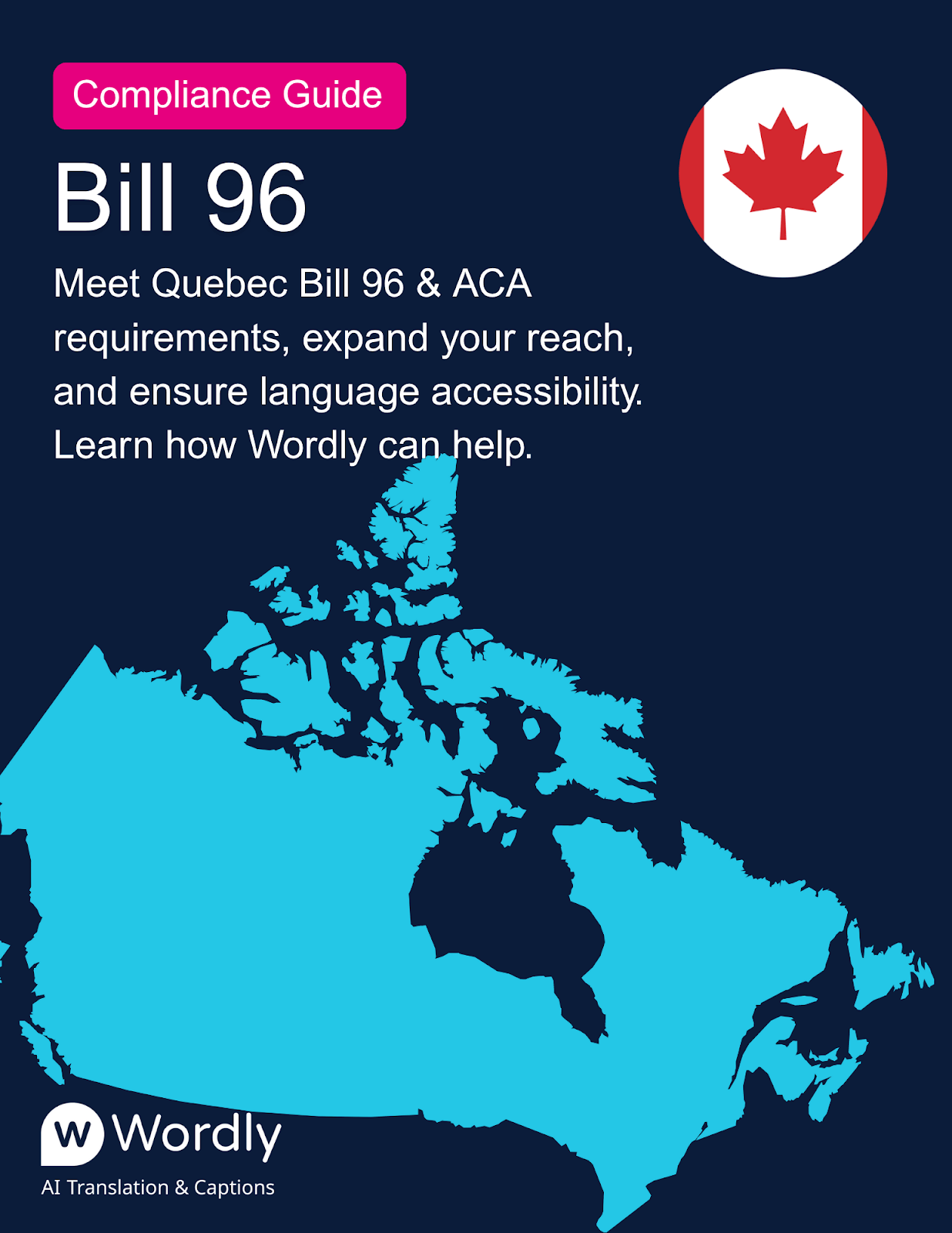Wordly Named One of the Fastest-Growing Software Companies in the U.S — Learn More
Accessibility is now a legal expectation in Canada. With acts like AODA (Accessibility for Ontarians with Disabilities Act), ACA (Accessible Canada Act), Quebec Bill 96, and other language requirements under the Official Languages Act, businesses need to prioritize accessibility across their platforms, services, and communication. But navigating these laws can be complex.
This page will break down Canada’s language accessibility standards, with a special focus on how businesses can comply with AODA, ACA, Bill 96, and other official language requirements. Whether you’re a business owner, legal professional, or accessibility consultant, this guide will help you understand key requirements and best practices.


Enacted in 2019, the Accessible Canada Act (ACA) is a law designed to promote accessibility for people with disabilities across Canada. It applies to federally regulated entities and aims to create a barrier-free Canada by January 1, 2040.
Who Needs to Comply?
The ACA applies to federal organizations such as government departments, banks, telecommunications companies, and interprovincial transportation providers. However, its principles serve as a strong benchmark for privately run businesses in other sectors.
Key Elements of ACA Compliance:
If your business operates in Ontario or serves Ontarian customers, you need to comply with the Accessibility for Ontarians with Disabilities Act (AODA). The AODA mandates accessibility for everything from physical spaces to digital platforms.
Key Requirements:
Failing to comply with AODA regulations isn’t just detrimental to your customer base; it can result in significant fines. Make sure your organization is aware of the deadlines for compliance.
Accessibility isn’t just about physical and digital barriers; language access plays a crucial role in inclusivity.
What Does the Official Languages Act Cover?
The Official Languages Act (OLA) ensures that English and French are treated equally in federal institutions and public communications. It protects the rights of Canadians to communicate in their preferred official language and receive services accordingly.
Key Areas of OLA Compliance:
The Growing Importance of Language Translation and Captions
Businesses serving a bilingual audience can leverage technology to comply with OLA requirements.
Wordly Live Translation provides automatic translation, captions, and subtitles for events, videos, and meetings. This makes it easier to engage customers in their preferred language while meeting regulatory requirements.
In June 2022, the Québec government passed a new law, Bill 96, an amendment to the Charter of the French Language, to promote the use of the French language in the province and also affirm that French is the common language of the Québec nation.
The law impacts all businesses operating and/or having employees in Québec, and many of Bill 96’s new requirements have already come into force since March 2023.

Quebec’s Bill 96 enforces French-language requirements across digital platforms, internal operations, customer interactions, contracts, events, and more. Learn how Wordly can help you meet aspects of Bill 96, expand your reach, and support every voice.
Download GuideWith Canada's multicultural and bilingual cities, integrating captioning and translation into your business approach isn’t optional.
Benefits of Captions and Translation for Businesses:
Wordly takes the heavy lifting out of caption creation and accurate translation. By syncing live transcription with automated translation, you’re not only saving time but also expanding the audience you can serve effectively.
Why Choose Wordly AI Translation?
Wordly offers a comprehensive language accessibility service tailored for Canadian businesses. With features like live translation, real-time subtitles, and accurate transcription in dozens of languages, including French and English.
Wordly can help you:
1. Conduct an Accessibility Audit
Before taking concrete actions, assess where your business currently stands. This includes evaluating your website, physical spaces, and communication channels.
2. Update Your Digital Infrastructure
Prioritize WCAG 2.0 Level AA compliance for websites and apps. This means ensuring navigation is accessible for screen readers and providing text alternatives for all visual-based content.
3. Train Your Employees
Fostering a culture of accessibility begins with education. Offer regular training sessions to employees on assisting individuals with disabilities in a respectful and effective manner.
4. Leverage Technology
Integrate Wordly AI Translation to manage captions, subtitles, and bilingual communication effectively.
5. Seek Expert Guidance
If you’re new to accessibility initiatives, consulting an expert (or an accessibility-focused platform like Wordly) can make the compliance process smoother and stress-free.
✅ Real-time French translation for multilingual meetings and digital services.
✅ Captions & transcripts in French, English, and dozens of languages to provide accessible public communications.
✅ Text-to-speech option for visually impaired individuals.
✅ Fully automated and no human interpreters needed, reducing costs and delays.
✅ Seamless integration works with Zoom, Microsoft Teams, and other meeting platforms.
✅ Meets compliance standards to help agencies avoid legal risk.
Learn how translation software works.

One of many features included with Wordly.
Penalties for Non-Compliance:
❌ Fines up to $30,000 CAD per infraction for businesses and public entities.
❌ Loss of government contracts and operational restrictions.
Accessibility goes beyond compliance; it builds trust with customers and credibility in your industry.
While Wordly helps with Canada Bill 96 compliance, it also supports multilingual accessibility under international laws — learn more about the European Accessibility Act 2025.
If you’re ready to elevate your language accessibility efforts with smarter captioning and translation solutions, Get a Demo and see Wordly AI Translation in action.